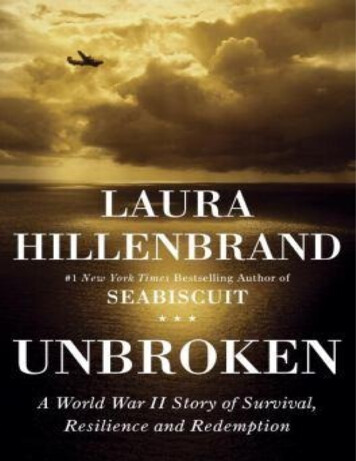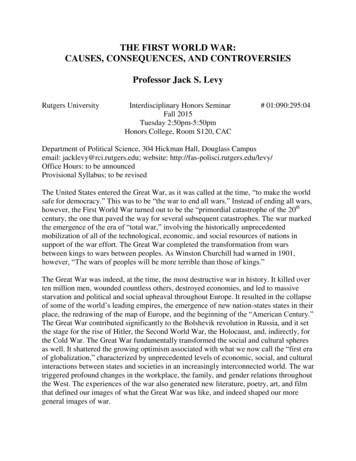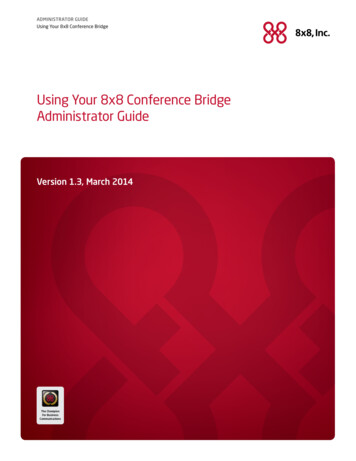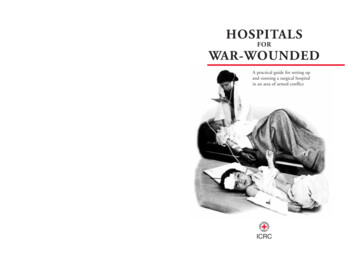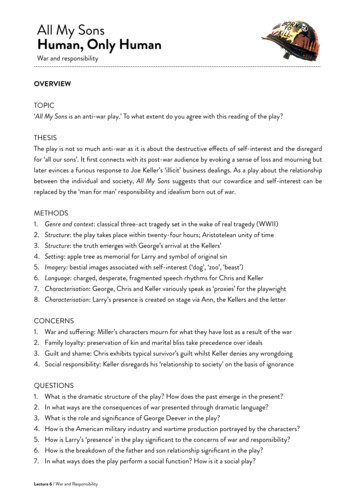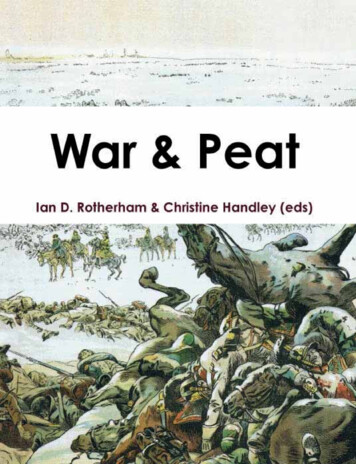
Transcription
War & PeatThe remarkable impacts of conflicts onpeatlands and of peatlands on conflicts- a military heritage of moors, heaths,bogs and fens.Edited by Ian D. Rotherham and Christine HandleyLandscape Archaeology and Ecology, Volume 10, 2013.
Edited by Ian D. Rotherham and Christine HandleyISSN 1354-0262ISBN 978-1-904098-55-3Published by:Wildtrack Publishing, Venture House,103 Arundel Street, Sheffield S1 2NTTypeset and processed by Christine HandleySupported by:Biodiversity and Landscape History Research Institute.Sheffield Hallam University.HEC Associates.South Yorkshire Biodiversity Research Group.Landscape Conservation Forum.Sponsored by:British Ecology Society.International Peat Society.Front cover picture: 1807 Napoleonic battlefield Sur le Nemen Wildtrack Publishing and the individual authors 2013.All rights reserved. No part of this publication may be reproduced or transmitted in anyform or by any means, electronic or mechanical, including photocopying, recording,or any information storage or retrieval system, without permission in writing from thepublisher.
German and Russian troops at the Battle of Tannenburg in 1914
ContentsAn Introduction to War & Peat1Ian D. RotherhamWar & Peat: exploring interactions between people, human conflict,peatlands, and ecology7Ian D. RotherhamMilitary LandscapesMilitary pastoral and the military sublime in British army training landscapes45Rachel WoodwardBeyond the barbed wire: accessing Britain’s military training areas57Marianna DudleySaint Helena, an island of dry deserts and constant rain: conserving an uniquemilitary heritage in a changing climate65Edmund SimonsCannock Chase: conserving the military heritage79Stephen DeanAshley Walk Bombing Range, New Forest, Hampshire91Richard HallBattles and BattlefieldsBogs as defence in the seventeenth century Dutch Republic105Michiel GerdingThe battlefield at Northampton (Wars of the Roses, 1460)115Peter BurleyIn to the bog: ‘silently and in good order. German fashion ’135Chris BurgessThe effect of marsh, bog and moor environments on the execution of warfare,with particular reference to the Early Modern period in Britain and EuropeSean Bell139
The Impacts of Conflict and WarThe impact of the Falklands War (1982) on the peatland ecosystem ofthe islands143Jim McAdamAviation archaeology: a legitimate branch of archaeology? Its developmentand path to professional standards163Graham R. ChatersRadionuclide sorption on the peat187Andris Abramenkovs, Maris Klavins, Janis Rudzitis and Andris PopelisWar and forest195Pekka VirtanenSphagnum: the healing harvest201Thelma Griffiths, Ian D. Rotherham and Christine HandleyWar & Peat in the Peak DistrictImpacts of conflict and war on peatland landscapes221Paul A. ArdronBurbage and Houndkirk in the Second World War: defending Sheffieldand training the liberators233Bill BevanBig Moor shadow woodland surveys World War Two field finds237Andy AlderLangsett and Midhope at War 1939-1945241Mike G. KirbyLocal memories of military impacts on the Peak District: air crashes,defences and training areas247Christine HandleyNon-military CampaignsThe moorland access campaigns – (with some military interludes)257Terence HowardPeat, politics and patrimonialism: back to the future on Thorne MoorsKieran Sheehan273
War & Peat: the History, Archaeology & Ecology of the Military Heritage of Moors, Heaths, Bogs and FensAn Introduction to War & PeatIan D. RotherhamSheffield Hallam UniversityA short introductionhad been hugely influential in thetheatre of war. It was these wideranging and varied issues, which we setout to address under the banner of ‘War& Peat’.As we approach the centenary of thecommencement of World War One,matters of landscape, terrain, resourcesand strategies become increasinglytopical and relevant. The themes of thisbook were addressed at a majorinternational conference in 2013, andthe expanded papers are presented hereas chapters. The conference and bookare mostly focused on temperateenvironments, but the interactions ofpeatlands and conflicts are more global.From the Second World War in forexample the Philippines, to the Britishin Burma, and later the Americans inVietnam, wetlands have been hugelyinfluential in tropical conflicts too.However, the theme of this researchis not restricted to the conflictsdescribed above. Throughout history,peatlands have been contestedlandscapes and resources. These‘battles’, such as the ‘Peat Campaign’of the 1980s and 1990s, to save the lastremaining lowland raised mires inEngland, are one such example. Withoutthe campaign, sites like Thorne Moorsand the Humberhead Levels would nowbe landfill, mineral extractionlandscapes, or perhaps intensivefarming. From the 1920s and 1930s, theaccess campaigns grew in cities likeSheffield and Manchester, to claim backaccess rights to moors and bogs lostunder enclosures in the 1700s and1800s. By the early millennium, accessto the wider countryside in England wasfinally given back as a legal right;another battle won.The relationships of people andlandscapes, of economies and conflicts,and ecology and history, are complexand multi-faceted. For peatlands,including bogs, fens, moors, and heaths,the interactions of people and nature inrelation to history and conflicts, areboth significant and surprising. The ideaof ‘War & Peat’ in fact emerged fromlong-term studies of peatlands, theirhistories of utilisation, and the impactson ecologies. In particular, it becameclear that conflicts and strife such aswar, political and economic unrest, orextreme weather for example, had hadgreat impacts of peatlands. Furthermore,peat landscapes of various sorts had notonly affected regional economics, butThese peat-based landscapes havebeen radically affected by humanhistory and human utilisation. Importantto realise too, is that the major effect ofhistoric usage has been a reduction inextent of peatlands which is almostbeyond imagination. To understandmore fully the roles of peatlands in1
War & Peat: the History, Archaeology & Ecology of the Military Heritage of Moors, Heaths, Bogs and Fenstimes of conflicts and stresses, you mustfirstly appreciate just how widespreadthey were. Additionally, the nature andcondition of pre-industrial sites weredramatically different from the sites thatremain today. Bogs for example, werewetter and deeper, and more abundantand widespread in the landscape, and sotheir influence on people was muchgreater.5. Peatlands, especially bogs and fens,provided materials of immensevalue to wartime efforts such assupplying horse litter, sphagnummoss, alder buckthorn or peat fuel.6. Conflicts, socio-economic stressesor extreme weather all influencedfuel use and competition andtherefore peat exploitation.7. Fens and bogs as places ofsanctuary, of non-conformism, andindependence.An approach to the subjectThe approach we have developed to thesubject is to consider both the integratedwhole in terms of peatlands and people,but also the component elementsseparately. This allows us to separateout the individual stories but then tobring together the overall context anddescription of the relationships betweenwar & peat.Some final pointsMost of the uses noted above hadimpacts on the peatlands and these varyfrom complete removal, to drainage, tomodification and perhaps recovery.Some, such as the strategic significancein battlefields left relatively littleevidence of a perhaps pivotal role.1. Peatlands influence war and conflictthrough topography and nature,often being of critical significanceto strategy and outcome.However, many wartime or conflictuses have left a visible heritage such asthe pockmarked boulders of the PeakDistrict moors, scarred by wartimebullets and mortar blasts. Otheractivities such as Sphagnum mossharvesting left little visible record andindeed, only a tenuous documentationor oral history; so much more remainsto be found out and recorded.2. Heaths and moors were often usedas military training grounds, fromearly times up to the present day.3. Peatlands were used as wartimebases especially during World War 2when they were brought into usageas airfields and similar facilities.Many of the uses, through alterationto sites, drainage and even topographyitself, had far-reaching consequences forthe resource. This is perhaps the storyof this conference.4. Bogs and moors especially, hadunplanned and passive roles inwarfare such being the last restingplaces for stricken or lost bombersof both sides during World War 2.With the 2014 anniversary of the startof the First World War, the majorconference at Sheffield Hallam2
War & Peat: the History, Archaeology & Ecology of the Military Heritage of Moors, Heaths, Bogs and FensFigure 1. Durham Light InfantryFigure 2. Control Stirling Castle and with the River Forth and Flanders Moss, then youcontrol Scotland3
War & Peat: the History, Archaeology & Ecology of the Military Heritage of Moors, Heaths, Bogs and FensFigure 3. WW1 Belgium battlefieldFigure 4. WW2 USA Army inthe Philippines4
War & Peat: the History, Archaeology & Ecology of the Military Heritage of Moors, Heaths, Bogs and FensBibliography & ReferencesUniversity, and now this book are calledfittingly, ‘War & Peat’. Involving notonly researchers and academics, butordinary local people too, this addressesimpacts of conflicts on peatlands andtheir usage and products. The subjectsrange from battlefields and strategicimpacts of peatlands and wetlands inconflicts, harvesting Sphagnum moss,peat as horse litter, and as fuel, use formilitary training, and the battles foraccess, for conservation and more.Along with recollections, we also havephotographs of people involved and thisformed the basis of an exhibition at theSeptember 2013 Conference.Rotherham, I.D. (1999) Peat cutters andtheir Landscapes: fundamental changein a fragile environment.In: PeatlandEcology and Archaeology: managementof a cultural landscape. LandscapeArchaeology and Ecology, 4, 28-51.Rotherham, I.D. (2005) Fuel andLandscape – Exploitation, Environment,Crisis and Continuum. LandscapeArchaeology and Ecology, 5, 65-81.Rotherham, I.D. (2008) The importanceof cultural severance in landscapeecology research. Abstract paper in:Governing Shared Resources:Connecting Local Experience to GlobalChallenges. Proceedings of 12thBiennial Conference of the InternationalAssociation for the Study of Commons(IASC), Cheltenham, July 14-18, 2008.189.The research continues and peopleacross Yorkshire or beyond, may stillremember the Sphagnum harvests ormaybe their parents or grandparentswere involved. If so, then we need tohear from you to record and celebratethis remarkable tale of the healingharvest of the peat bogs. Photographs orother memorabilia would be hugelyinteresting too. Additionally, othermemories or information on uses ofheaths, moors, bogs, fens, Sphagnummoss, or related matters, from the HomeGuard to the RAF, would be very usefulto our studies. The event was organisedwith Sheffield Hallam University by theSouth Yorkshire Biodiversity ResearchGroup, the Biodiversity & LandscapeHistory Research Institute, TheLandscape Conservation Forum, theBritish Ecological Society, and theInternational Peat Society, and we aregrateful for their support. WildtrackPublishing published the book on theirbehalf.Rotherham, I.D. (2009) Peat and PeatCutting. Shire Publications, Oxford.Rotherham, I.D. (2010) Yorkshire’sForgotten Fenlands. Pen & SwordBooks Limited, Barnsley. 181pp.Rotherham, I.D. (2013) The Lost Fens:England’s Greatest Ecological Disaster.The History Press, Stroud.Rotherham, I.D., Egan, D. and Ardron,P. A. (2004) Fuel economy and theuplands: the effects of peat and turfutilisation on upland landscapes. Societyfor Landscape Studies SupplementarySeries, 2, 99-109.5
War & Peat: the History, Archaeology & Ecology of the Military Heritage of Moors, Heaths, Bogs and FensRotherham, I.D. & McCallam, D.(2008) Peat Bogs, Marshes and Fen asdisputed Landscapes in Late eighteenthCentury France and England. Lyle, L.&McCallam, D. (eds) Histoires de laTerre: Earth Sciences and FrenchCulture 1740-1940. Rodopi B.V.,Amsterdam & New York, 75-90.Rotherham, I.D. & Handley, C. (2012)Moor Memories from across the PeakDistrict. Wildtrack Publishing,Sheffield, 44pp.Rotherham, I.D. & Handley, C. (2012)Mosses and Cloughs. Moor Memoriesin the Holme Valley area. WildtrackPublishing, Sheffield, 32pp.Rotherham, I.D. & Handley, C. (2012)Hills, Dykes and Dams. Moor Memoriesin the Bradfield, Midhope and Langsettareas. Wildtrack Publishing, Sheffield,32pp.Figure 5. Tolstoy and our aplogies to the greatmanFigure 6. War & Peace as published byPenguin and based on the colossal BBCdramatization6
War & Peat: the History, Archaeology & Ecology of the Military Heritage of Moors, Heaths, Bogs and FensWar & Peat: exploring interactions betweenpeople, human conflict, peatlands, and ecologyIan D. RotherhamSheffield Hallam UniversitySummary6. Conflicts, socio-economic stressesor extreme weather all influencedfuel use and competition andtherefore peat exploitation.This chapter addresses the issues ofpeople, peatlands, conflict and ecology.It does so by considering seven maininteractions and presents pertinentexamples to illustrate these.7. Fens & Bogs as places of sanctuary,of non-conformism, andindependence.1. Peatlands influence war and conflictthrough topography and nature,often being of critical significanceto strategy and outcome.The central argument is thatpeatlands of varying sorts have beenhugely important to people in times ofconflict or stress, and that the resultinginteractions have had major impacts onthe ecology and landscapes we seetoday. In addition, it is suggested, thatmost of these complex phenomena havebeen largely overlooked or at leastforgotten.2. Heaths and moors were often usedas military training grounds, fromearly times up to the present day.3. Peatlands were used as wartimebases especially during World War 2when they were brought into usageas airfields and similar facilities.Introduction4. Bogs and moors especially, hadunplanned and passive roles inwarfare such being the last restingplaces for stricken or lost bombersof both sides during World War 2.Peatlands such as heaths, moors, bogsand fens have all been of importanceand significance in the landscape and topeople in many parts of the world andthroughout many centuries. In terms ofthe land areas covered, sphagnum mossitself must rate as one of the mostabundant plants on Earth. This scale ofsignificance and the nature of theselandscapes have led to a remarkablerelationship throughout the history ofhuman conflicts and stresses andpeatlands, especially in times of war.5. Peatlands, especially bogs and fens,provided materials of immensevalue to wartime efforts such assupplying horse litter, Sphagnummoss, alder buckthorn or peat fuel.7
War & Peat: the History, Archaeology & Ecology of the Military Heritage of Moors, Heaths, Bogs and FensSome of the issues and observations arediscussed in my three books, Peat &Peat Cutting (Rotherham, 2009),Yorkshire’s Forgotten Fenlands(Rotherham, 2010), and the Lost Fens(Rotherham, 2013). However, whilstissues of landscapes and conflict, andespecially ‘landscapes of conflict’ havereceived attention in recent years (e.g.Pearson, 2008, 2012; Cole, Coates, &Pearson, 2010), the roles of wetlandsgenerally, and peatlands specifically,have for the most part, been ignored.Academic authors have begun toaddress these issues for example inrelation to broader matters of terrainand warfare (e.g. Doyle & Bennett,2002), and in relation to environmentalfactors (e.g. Tucker & Russell, 2004).I suggest there are perhaps sevenmain ways in which people andpeatlands have interacted in times ofconflict or other stresses, and I presentexamples below. Some of the uses andinteractions are developed further laterin the paper.Impacts, utilisation andexamples1. Peatlands influence war andconflict through topography andnature, often being of criticalsignificance to strategy andoutcomeExamples: The military significanceand use of moors, heaths, fens and bogs,extends over millennia. The moors andbogs around the western edge ofSheffield with their Iron Age hillfortscan trace a military presence acrossmillennia. In modern times, they werenot only used as military traininggrounds, but also during WW2 as adecoy area to protect the vital steelindustry to the east of Sheffield. Moorsand heaths also provided the sites forairfields for the Battle of Britain and thestrikes against Nazi Germany.For moors, bogs, heaths and fens,conflict does not just mean battlefieldsfor conventional warfare, but forcontested spaces. From the battles forKinder Scout and access to the moors,to saving Thorne Moors and HatfieldChase, peat bogs and moors have beenevocative places for the region’s people.Not only this, but they played a majorrole in the war effort of two World Warstoo. Forgotten wartime aspects of peatbog and fen were things like the supplyof vital horse-litter (cut peat turf) fromsites such as Thorne Moors in SouthYorkshire. Conflicts over the proposeddrainage of the Fenlands were even akey factor in triggering the EnglishCivil War in the 1600s. It is clear thatpeople and peatlands interact in manycomplex and complicated ways.Furthermore, human conflicts affect andare influenced by these once vastlandscapes.However, there is more. Wetlands,especially peat bogs, fens and moorswere of huge significance to militarycampaigns. In the landscape, thesetreacherous areas of neither firm groundnor navigable water were a seriousproblem for soldiers or warriors, mostof who could not swim anyway.Furthermore, slip into a fen or bogwhen wearing armour and you sinkslowly to a very unpleasant death. The8
War & Peat: the History, Archaeology & Ecology of the Military Heritage of Moors, Heaths, Bogs and FensSaxon troops of Hereward the Wake,holding out on the Isle of Ely inCambridgeshire, drove the Normaninvaders off the fragile causeways byfiring the reeds. The Normans in theirchainmail sank deep into the quagmire.The battle of Stamford Bridge hadearlier been settled in a vast wetlandlandscape in which the one rivercrossing was vital strategic key. Thisaspect of wetlands in the landscape wasused to great effect by the Scots againstthe English at the battles of StirlingBridge and of Bannockburn. Battlessuch as Solway Moss, Culloden, andFlodden all turned on the impact of abog or wet moor, in these cases withcatastrophic consequences for the Scots.Flanders Moss and the River Forthwere of huge strategic significance inScotland, and it was said that he whocontrolled Stirling Castle, the gatewayto the Highlands, controlled Scotland.In England, many of the battles of thecivil wars such as the Wars of theRoses, and of the English Civil War,were acted out on heath, moor, and bog.The Battle of Sedgemoor itself was atragedy played out in a foggy, dankmarshland, and earlier, Alfred the Greathad sought refuge in the nearbywetlands of Athelney.In the European arena of the twoWorld Wars, peat bogs and fens playeda major strategic role, with the Dutchfor example, flooding the former peatcuttings to halt the German advance asthey retreated. The Somme and othercatastrophic campaigns were fought invast wetlands and peat bogs.2. Heaths and moors were oftenused as military traininggrounds, from early times up tothe present dayExamples: Around Sherwood, thefamous heaths of old Sherwood Forestbecame military training grounds, andin WW2, Clumber Park was a transitand camouflaged storage site for tanks.Dartmoor, Cannock Chase and otherheath and bog sites were used formilitary manoeuvres probably as farback as the Crimean War.Figure 1. Battle of Solway Moss November1542 15,000-18,000 Scots routed by 3,000English9
War & Peat: the History, Archaeology & Ecology of the Military Heritage of Moors, Heaths, Bogs and FensFigure 2. Cannock Chase 1873Figure 3. Dartmoor 1870Figure 4. Hampstead Heath August 186010
War & Peat: the History, Archaeology & Ecology of the Military Heritage of Moors, Heaths, Bogs and Fensbuckthorn or peat fuel3. Peatlands were used aswartime bases especially duringWorld War 2 when they werebrought into usage as airfieldsand similar facilitiesExamples: Early twentieth centurywartime aspects of peat bog and fensuch as the supply of vital horse-litter(cut peat turf) from sites like ThorneMoors in South Yorkshire, or theharvesting of sphagnum for wounddressings,are now almost forgotten.Examples: In Nottinghamshire andLincolnshire, commons, heaths, andfens were turned to use as airfields;some still surviving today. Moors andheaths provided the sites for airfieldsfor the Battle of Britain and the strikesagainst Nazi Germany.One of the main uses of peat in thelate 1800s and early 1900s was litter foranimal bedding. With huge numbers ofanimals powering farms, towns andcities, there was a big demand formaterial to keep things clean, and peatwas ideal. Once soiled, its nutritivequalities enhanced, it went on the landas fertiliser. At Thorne Moors in SouthYorkshire, the English Moss Littercompany extracted peat moss up to the1960s, and from 1923 to 1962, theMidland Litter Company took mossfrom Fenn’s Moss near Wrexham.Although raw peat was widely used aslitter by farmers and peasants, widerusage took off in the early 1900s.Processed and packaged as acommercial product, during the FirstWorld War with its absorbent andfibrous combined with antisepticproperties it was used extensively ashorse bedding for the military.4. Bogs and moors especially,had unplanned and passive rolesin warfare such being the lastresting places for stricken orlost bombers of both sidesduring WW2Examples: In Roman times, the fensand bogs were brought under varyingdegrees of control through ambitiousdrainage schemes, but the primaryfunction of these waterways wasprobably military in moving men,animals and supplies speedily throughotherwise difficult terrain.These landscapes also became thelast resting places of aircraft and crewsthat crashed on Kinder Scout andBleaklow in the uplands, and ThorneMoors in the lowlands. This is a tragichistory, which should not be forgotten.It was also used as animal feed,mixed with green fodder and perhapsmolasses. Again its antibacterialproperties may have a therapeutic effectand it was used either coarse or as apowder mixed into a cattle cake.5. Peatlands, especially bogs andfens, provided materials ofimmense value to wartimeefforts such as supplying horselitter, Sphagnum moss, alderTo give some indication of theemerging demands for peat moss litter,there was now nationally an increase of11
War & Peat: the History, Archaeology & Ecology of the Military Heritage of Moors, Heaths, Bogs and Fensaround 98,353 working horses between1901 and1906. These were employed byrailways, tramways, omnibuscompanies, various local authorityundertakings and of course many otherbusinesses. Peat moss litter (dried peat)made an ideal bedding material forthem. By the late 1890s, at ThorneMoors, the British Moss LitterCompany was formed and took over anumber of established peat works acrossthe region between the Rivers Don andTrent. Alongside the system of canalsand boats there developed a network ofnarrow gauge railways and connectionsbeyond to the wide rail network. A new‘pressing mill’still known as the‘Paraffin Mill’ or the ‘Paraffin Works’was being built in 1895. This was toproduce gas for fuel, ammonia water,paraffin, creosote, methyl alcohol, tarand even alcohol for motorcars. Peatdust was used to pack fruit and peat waseven fed to cattle. However, thesediversifications did not last long and themill closed in 1922. With declining useof horses for industry and transport, themoss litter business also collapsed.South Yorkshire moors. The region’smoors and bogs were also used toharvest sphagnum moss for wartimemedical uses. (See Griffiths, Rotherham& Handley, this volume).6. Conflicts, socio-economicstresses or extreme weather allinfluenced fuel use andcompetition and therefore peatexploitationExamples: Often forgotten, are theeffects of post-conflict scenarios such asafter WW2 in Britain and the resultingenergy crisis for domestic and industrialfuels. At Holme Moss, in the southPennines, one of England’s lastcommunity turbaries (legal peat cuts fordomestic fuel), two discharged soldiersarrived after the Second World War toset up business. Recently dischargedfrom the army, they used their money toset up a peat fuel business and forseveral years, in the post-war energycrisis, they supplied peat fuel tofactories as far away as Sheffield andLeeds. Similar exploitation affected thepost-WW2 blanket peats of the southwest Pennines as large areas were cutfor peat fuel to supply Pilkington Glass.Established as a major centre formoss litter production, and employingat its peak around 350 men, ThorneMoors in South Yorkshire produced vastquantities of peat litter for the horsessent to the World War 1 front line. Inthe First World War, many horses weredespatched to war zones and they had tobe catered for. Horticultural use of peatwas a much later afterthought thatbrought catastrophe to the region’s peatmoors and bogs, triggering the battlesby ‘Bunting’s Beavers’ and others tosave the last remnants of the once vastWar also meant on the one handintensification of land use and WW2brought about the final demise of theremaining Southern Fens of easternEngland. On the other hand, conflictcould lead to the abandonment of forexample, drainage schemes. AtWalberswick in Suffolk, marshlanddrainage was unmaintained and thisallowed reversion to fen and marsh.Around Leighton Moss, the long12
War & Peat: the History, Archaeology & Ecology of the Military Heritage of Moors, Heaths, Bogs and Fensup to this conference, we made aremarkable discovery. Something foundby me and Thelma Griffiths of theNational Trust at Longshaw in the PeakDistrict resonated with an interviewwith locals at Holme Moss who hadspoken of people collecting Sphagnumor bog moss for the war effort in 1940s.We were told of a hitherto forgottenway in which people across Yorkshirewent out to collect a healing harvestfrom peat bogs and mires across thecounty. Sphagnum moss, todayassociated with hanging baskets, hasremarkable properties to hold liquid andto cure or stop infection. In a medicalworld pre-antibiotics the combination ofthe power to mop up copious quantitiesof blood and staunch open wounds, andits healing powers, made sphagnuminvaluable for helping the terribleinjuries of war. (The sphagnum story ispresented in more detail in otherpapers).standing peat cuttings were abandonedas the site re-wetted due to neglect ofdrainage. The ultimate result in bothcases has been the development ofmajor nature conservation sites by thetwenty-first century.7. Fens & Bogs as places ofsanctuary, of non-conformism,and independenceThroughout history, peat bog and fenhave provided sanctuary for people intimes of conflict or oppression, and fornon-conformists and others seeking todistance themselves from the law or thechurch. Rich in natural resources forthose who knew and understood theirways, but difficult to enter or transverseif you did not, these were idealhideaways from the time of Alfred theGreat to Hereward the Wake, and fromthe nineteenth-century French forces inthe Franco-German war, to the MarshArabs of Iraq seeking protection fromSaddam Hussein. One consequence ofthe sanctuary that wetlands gave fromthose in authority was that those inpower sought to remove them from thelandscape and to control both theenvironment and the people.The story relates to landscape changeacross the county, since at the time, peatbogs and wetlands were morewidespread across England, andespecially prevalent and important inYorkshire. Therefore, the call went outto communities and people across thecounty to go to the bogs and harvest thesphagnum. This was then carefullyprocessed and shipped out to the frontor to hospitals where the injured werebeing treated. Our research has foundthat some people still remember howthis was done, if not themselvesdirectly, then from parents or evengrandparents. At Longshaw in the PeakDistrict, we have found a family whoserelative, a nurse, helped gather moss forResults: The case studies inmore detailThe particular case of theSphagnum harvestThe once widespread peat bogs andmoors of Yorkshire also helped aremarkable national and internationaleffort to save the wounded in two worldwars. As a part of the research building13
War & Peat: the History, Archaeology & Ecology of the Military Heritage of Moors, Heaths, Bogs and Fensattended the National Trust talk byThelma, they had only half-believedgrandma’s tales of roaming the moors insearch of moss. However, further northin the Pennines, at Holme Moss, wehave older people that still recall thecollection of sphagnum during theSecond World War. A pattern isemerging, and it is now clear that thiswas no cottage industry but a majorundertaking and in places an industrialoperation. Huge efforts went intocollecting, sorting, processing andpackaging the healing harvest, and thiswas across Britain, from North America,and in Europe itself.Magazines and newspapers carriedstories and calls for action fromvolunteers. The Northern Rambler, June1942, for example stated ‘FORFigure 5. Sphagnum for the hospitals, Country MOORLAND WALKERS. Sphagnummoss is wanted for surgical dressings.Life, XXXIX, Saturday January 1st 1916There is an urgent demand for this. It isthe sick. Thelma met the family at aonly necessary to squeeze out theNational Trust event and the storysurplus moisture before packing.unfurled about their grandmother. DorisSupplies should be sent to EV BenettEmma Elliott was born in StanningtonStanford, Pythouse Hospital Suppliesin 1898, and worked at Longshaw as aand Comforts Depot, Tisbury. PostageVAD (Volunteer) nurse in 1918. Thiswill be refunded.’was when she was 20 years old. Hergranddaughter, Beverley Hardy, came toNevertheless, there were stillone of Thelma’s
The battlefield at Northampton (Wars of the Roses, 1460) 115 Peter Burley In to the bog: ‘silently and in good order. . book were addressed at a major international conference in 2013, and . Terre: Earth Sciences and French Culture 1740-1940. Rodopi B.V., Amsterdam & New Yor




